Category: Leadership
Grocery Industry HR Survey 2025: Key Insights for Regional Retailers

Posted by Humaculture®
September 18, 2025
With grocery prices up ~25% since 2020 and labor shortages intensifying, regional grocers need innovative workforce strategies to stay competitive. At Humaculture®, we’re excited to launch the Grocery Industry HR Survey 2025, designed to deliver actionable insights for regional grocery stores facing grocery HR challenges like turnover, rising costs, and policy shifts.
Why Participate in the Grocery Industry HR Survey?
The Grocery Industry HR & Benefits Survey uncovers correlations between HR practices, total rewards, and outcomes like employee retention, productivity, and labor cost management. By joining, you’ll gain:
- Exclusive Benchmarking: Compare your practices to industry trends.
- Actionable Insights: Address labor shortages in the grocery industry and optimize employee retention in grocery stores.
- Industry Leadership: Contribute to a report shaping grocery industry benefits trends.
Watch a replay of our Grocery Industry HR Survey 2025 Webinar to learn more.
Take the Grocery Industry HR Survey 2025 now.
Addressing Grocery HR Challenges in 2025
Regional grocers face unique pressures:
- Economic Shifts: New tariffs and inflation increase costs.
- Labor Shortages: Immigration policies risk short-term workforce gaps, raising labor costs.
- Competition: Big-box stores and discounters challenge market share.
- Consumer Trends: Private-label products hold over 20% market share with near-universal adoption, demanding agility.
Our survey explores regional grocery workforce strategies for:
- Attracting and Retaining Talent: Competitive compensation and benefits.
- Boosting Productivity: Training and workplace culture initiatives.
- Managing Costs: Balancing wages with operational efficiency.
Learn how our total rewards philosophy leads success in a grocery setting.
Engaging with the Grocery Industry
Humaculture® is committed to driving industry-wide impact by sharing insights at key grocery events where HR and workforce topics take center stage:
- Grocery Impact 2025 (November 5-7, Orlando): Focused on “The Power of People,” featuring sessions on leadership, talent development, and innovative HR strategies.
- Groceryshop 2025 (September 28–October 1, Las Vegas): A hub for grocery innovation, including discussions on tech-driven workforce solutions and supply chain impacts on labor.
These events align with 2025 HR trends like skills-based hiring, AI integration, and financial wellness programs—key areas our survey addresses. Join us to spark conversations on empowering regional grocers.
Survey Highlights
- Quick and Confidential: 25-30 minutes, anonymized responses.
- Comprehensive: Covers compensation, training, culture, and grocery industry benefits trends.
- Incentives:
- Executive summary and benchmarking report.
- Recognition in an upcoming Humaculture® whitepaper.
- Personalized report via a follow-up meeting.
Join Us to Shape Grocery HR
Take the Grocery Industry HR Survey 2025 and share on LinkedIn or X with #GroceryHR to drive industry change. For questions, contact any of our team members:
| Steve Cyboran | CEO, Consulting Actuary, Chief Behavioral Officer |
| Wes Rogers | President, Humaculturist® |
| Paula Labian | Former CHRO, HAC/Whole Foods |
| Marc Jones | Former CEO, HAC |
| Sam Martin | Former CEO, A&P, SVP Operations, Wild Oats Market |
FAQ: Grocery Industry HR Survey 2025
- What is the Grocery Industry HR Survey?
A 25-30 minute survey addressing grocery HR challenges like turnover, labor costs, and benefits for regional grocers. - How can regional grocers benefit?
Gain benchmarking data and actionable insights for employee retention in grocery stores. - Is it confidential?
Yes, responses are anonymized, ensuring candid feedback.
Humaculture® is a registered trademark of Humaculture, Inc.
People Development: A Humaculture® Perspective Series
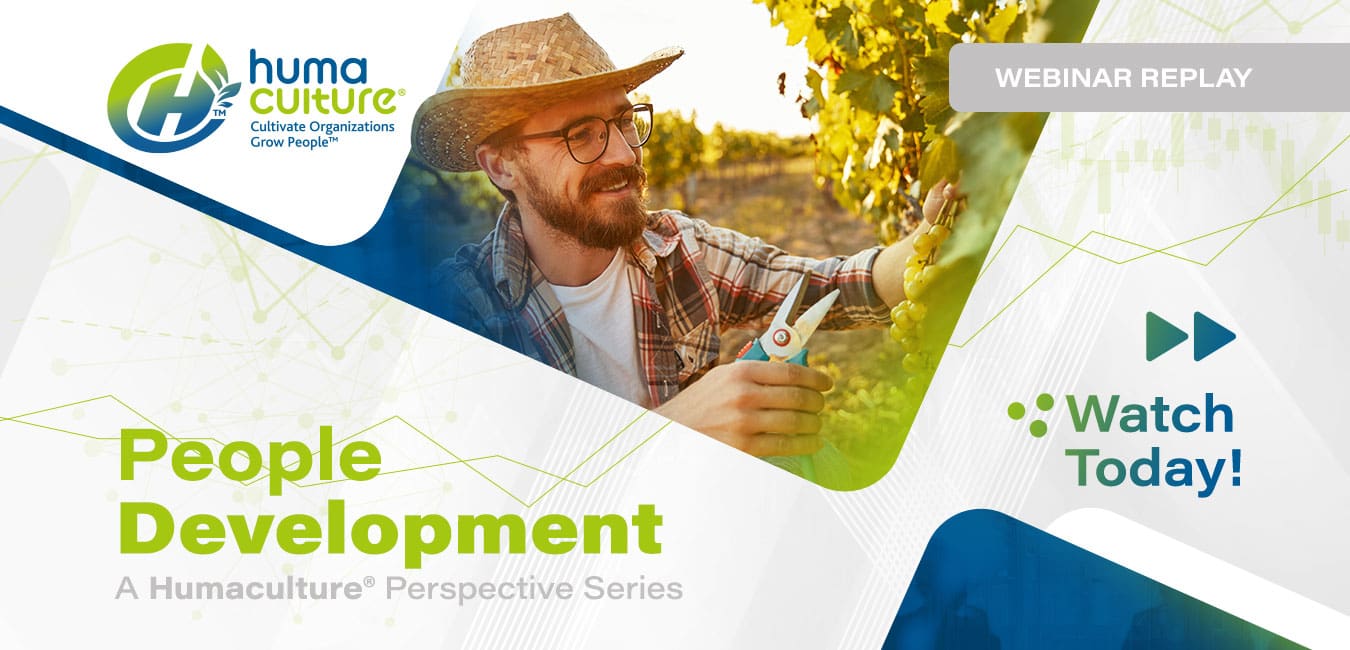
People Development Overview
In this webinar series, we explored ways organizations can rethink the traditional performance management and people development processes to make them more meaningful, impactful, and aligned with the organizational vision and strategy – focusing employees and leaders on what is truly important.
Successful horticulturists recognize the overwhelmingly positive impact of pruning. Pruning is the process of removing branches that:
- Are not supporting the desired shape of the plant the horticulturist seeks,
- Take energy from the plant that reduce productivity,
- Shade or otherwise interfere with the productivity of the other branches.
Effective pruning allows the plant to focus its energies in the most effective and productive areas. People, like plants, often expend energy and time in areas that distract them from achieving their highest and greatest purpose and contributions. In any organization, it is important to help employees remove or overcome the impediments that hold them back, and focus on the areas and interests that will really help them achieve their goals, as well as the strategic priorities of the organization. This series highlights several ways organizations can be innovative and more effective than traditional “performance management.”
The topics from the series include:
| Performance Management: Walking the Garden |
| The shift from Managing to Facilitating Growth |
| Shaping Talent for Success: Pruning the Vines |
| Capabilities: Prune to Encourage Growth |
| Career Planning: Effective Pruning Bears Fruit |
| Employee Development |
| Manager Development |
| Leadership Development |
Available Support
We are available to support you in your strategy, design, compliance, financial, and monitoring needs. To that end, our team of consultants, including actuaries, clinicians, behavioral health, pharmacy, and legal resources are available to guide you through the compliance process. Please contact us.
Optimal Behaviors: Making Optimal Behavior the Natural Choice

Optimal Behaviors Overview
Watch this webinar series to see how we explore ways organizations can incorporate research-based, practical approaches to create the conditions where Optimal Behaviors are the natural choice. Optimal Behaviors are those that are the most beneficial to the individual as well as the organization.
Horticulturists consider the impact of the conditions in which plants are grown (e.g., climate, soil structure, space and fertility, arrangement, companion planting). Growth and productivity improve when the context of each dimension is appropriately addressed. Expertise from fields like botany and soil sciences provide the successful horticulturist with the information to do their jobs well.
Similarly, Humaculturists® consider the Seven Dimensions of Humaculture® to employ knowledge solidly “rooted” in science for the best results. Behavioral Research Applied Technology Laboratory (BRATLAB), Virtuositeam’s research arm, set out to answer some crucial questions related to understanding changes in behavior and habit creation:
- Which habits really matter, and to what degree, to the three biggest hidden drivers of sustained performance at work, human health, happiness, and security?
- How do we support people to practice these habits in a way that they experience as easy and natural, and that leaves them feeling highly engaged with their employer?
Four Powers Model of Change
The result: the Four Powers Model of Change. This model helps organizations create a thriving culture by leveraging this key distinction: how people THINK they behave and make decisions, versus how they ACTUALLY behave and make decisions. Four Powers is based on behavioral theories and validated research, behavioral research laboratories, and BRATLAB’s own extensive field testing. BRATLAB looked across industries to find the influence techniques that have been successfully used for years to shape employee and customer behavior.
The topics from the series include:
- Introduction: “Creating the Conditions for Optimal Behavior”
- Spaces Context: “Grow a Willow in a Desert? The importance of Spaces”
- Context of the Self: “The Complexity of Each Person”
- Systems Context: “The Systems that Govern Behavior”
- Social Context: “How People Influence Each Other”
- Harvest Time: “Reaping the Fruit of Optimal Behaviors”
Prior Series
- Hidden Opportunities, A Strategic Compliance Series
- People Development: A Humaculture® Perspective Series
Available Support
We are available to support you in your strategy, design, compliance, financial, and monitoring needs. Our team includes experts in organization design, actuarial science, clinical, and legal can guide the process to achieve optimal behavior. Please contact us.
Webinar Replay: Harvest Time: “Reaping the Fruit of Optimal Behaviors”
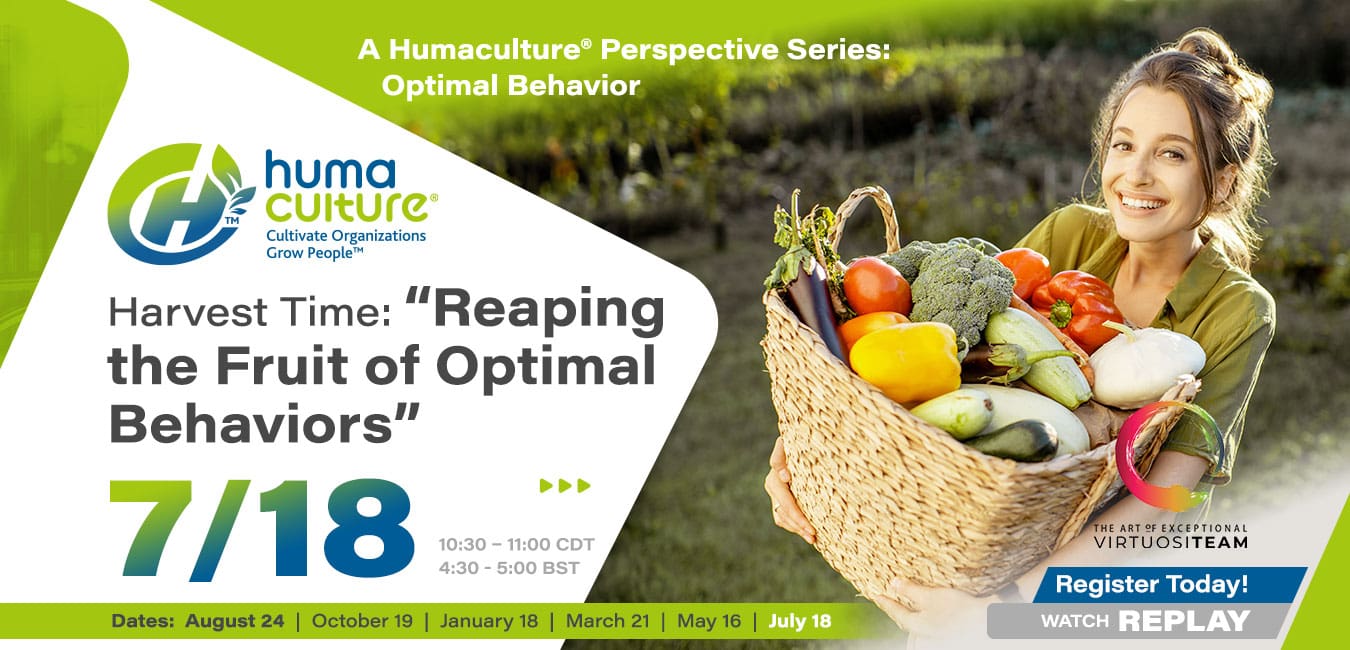
Watch a replay of the sixth and final webinar in Humaculture, Inc.’s “Optimal Behavior: Making Optimal Behavior the Natural Choice” to learn why and how to apply the four Contexts and four Powers of behavior change through a review of a case example.
Presenters
- Steve Cyboran, ASA, MAAA, FCA, CEBS, actuary and strategy consultant
- Wes Rogers, Humaculturist® and strategy consultant
- Colin Bullen, ASA, behavior change actuary
- Hanlie van Wyk, behavior change consultant
Objective
In this sixth and final session in our series on Optimal Behavior, we explore how to apply all the learning from the previous five webinars to reap a bountiful harvest produced by desired behaviors. To reliably achieve sustained Optimal Behavior, we consider all four Contexts – Spaces, Self, Systems, and Social. We do this by applying the Four Powers – the Powers to grow capability, inspire motivation, overcome barriers, and resist temptation – to align the influences acting on People toward supporting the change to Optimal Behavior. We will demonstrate the process of adjusting the Powers within the Contexts and the practical steps to take using a case study in the retail sector. We wrap up with the virtuous cycle that is the Change Ecosystem, showing how to reinforce Optimal Behaviors and ensure those behaviors stick. At the end of this webinar, attendees will understand how the Powers and Contexts come together to create the Four Powers behavior change framework and how that framework can be applied in practice.
“In the final analysis, change sticks when it becomes the way we do things around here.” – John P Kotter
Harvest Time Key Takeaways
Join us to learn how to apply the Four Powers model of change to reap the following fruits:
- Confident and capable People
- Inspired workplace
- Agile workforce
- People armored against distractions
Watch
Watch the Optimal Behavior: Harvest Time: “Reaping the Fruit of Optimal Behaviors” via Rumble or YouTube.
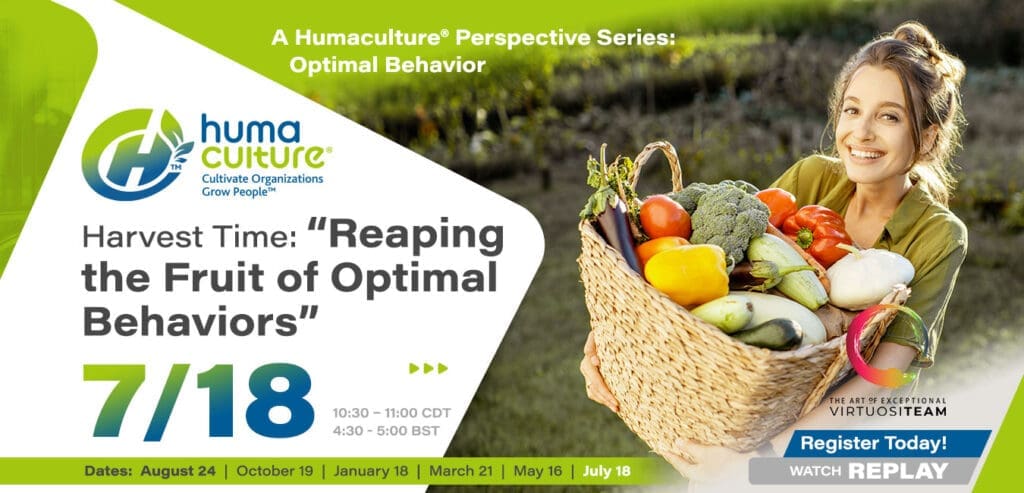
Available Support
We are available to support you in your strategy, design, compliance, financial, and monitoring needs. Our team includes business and human relations leaders, finance experts, actuaries, clinicians, behavioral health experts, pharmacy experts, and legal resources to guide you through the strategy and compliance process. Please contact us: [email protected].
Harvest Time: “Reaping the Fruit of Optimal Behaviors”
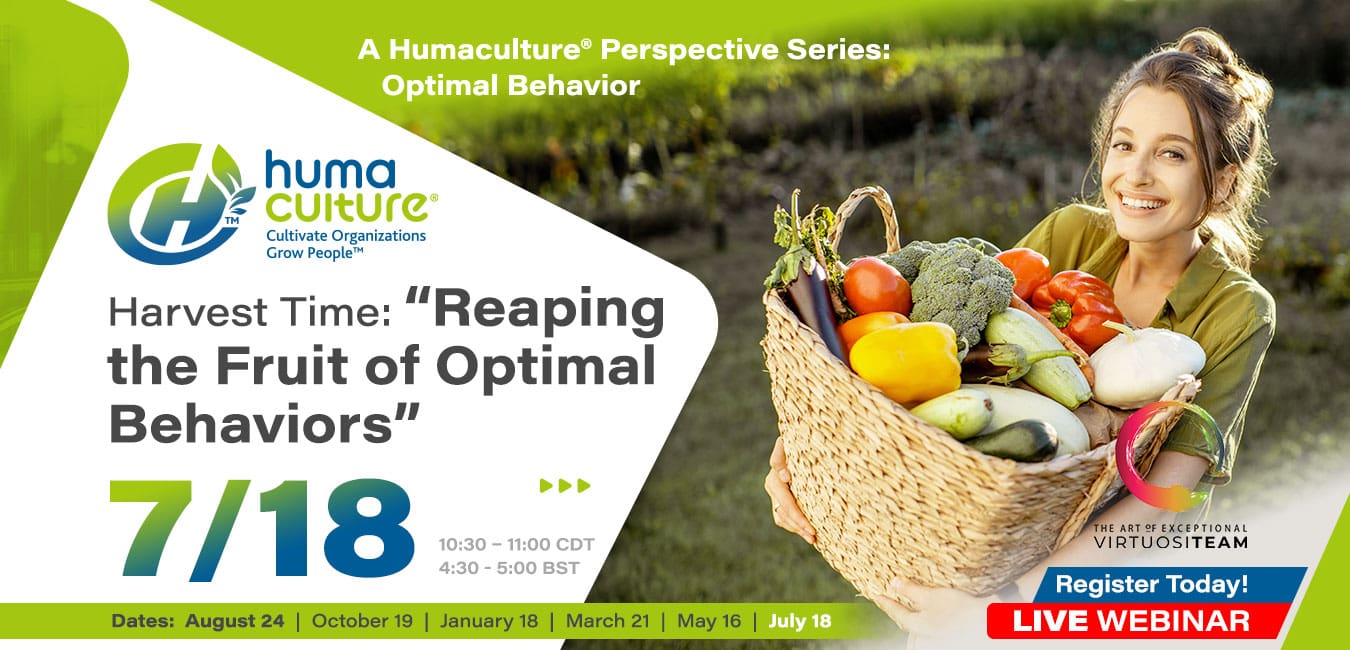
Join us on Thursday, July 18, 2024 from 10:30 to 11:00 CDT (4:30 to 5:00 BST) for the sixth webinar in Humaculture, Inc.’s “Optimal Behavior: Making Optimal Behavior the Natural Choice.” You will learn why and how to apply the four Contexts and four Powers of behavior change through a review of a case example.
Presenters
- Steve Cyboran, ASA, MAAA, FCA, CEBS, actuary and strategy consultant
- Wes Rogers, Humaculturist® and strategy consultant
- Colin Bullen, ASA, behavior change actuary
- Hanlie van Wyk, behavior change consultant
Objective
In this sixth and final session in our series on Optimal Behavior, we explore how to apply all the learning from the previous five webinars to reap a bountiful harvest produced by desired behaviors. To reliably achieve sustained Optimal Behavior, we consider all four Contexts – Spaces, Self, Systems, and Social. We do this by applying the Four Powers – the Powers to grow capability, inspire motivation, overcome barriers, and resist temptation – to align the influences acting on People toward supporting the change to Optimal Behavior. We will demonstrate the process of adjusting the Powers within the Contexts and the practical steps to take using a case study in the retail sector. We wrap up with the virtuous cycle that is the Change Ecosystem, showing how to reinforce Optimal Behaviors and ensure those behaviors stick. At the end of this webinar, attendees will understand how the Powers and Contexts come together to create the Four Powers behavior change framework and how that framework can be applied in practice.
“In the final analysis, change sticks when it becomes the way we do things around here.” – John P Kotter
Harvest Time Key Takeaways
Join us to learn how to apply the Four Powers model of change to reap the following fruits:
- Confident and capable People
- Inspired workplace
- Agile workforce
- People armored against distractions
Available Support
We are available to support you in your strategy, design, compliance, financial, and monitoring needs. Our team includes business and human relations leaders, finance experts, actuaries, clinicians, behavioral health experts, pharmacy experts, and legal resources to guide you through the strategy and compliance process. Please contact us: [email protected].
Webinar Replay: Effective Pruning Bears Fruit: Leadership Development
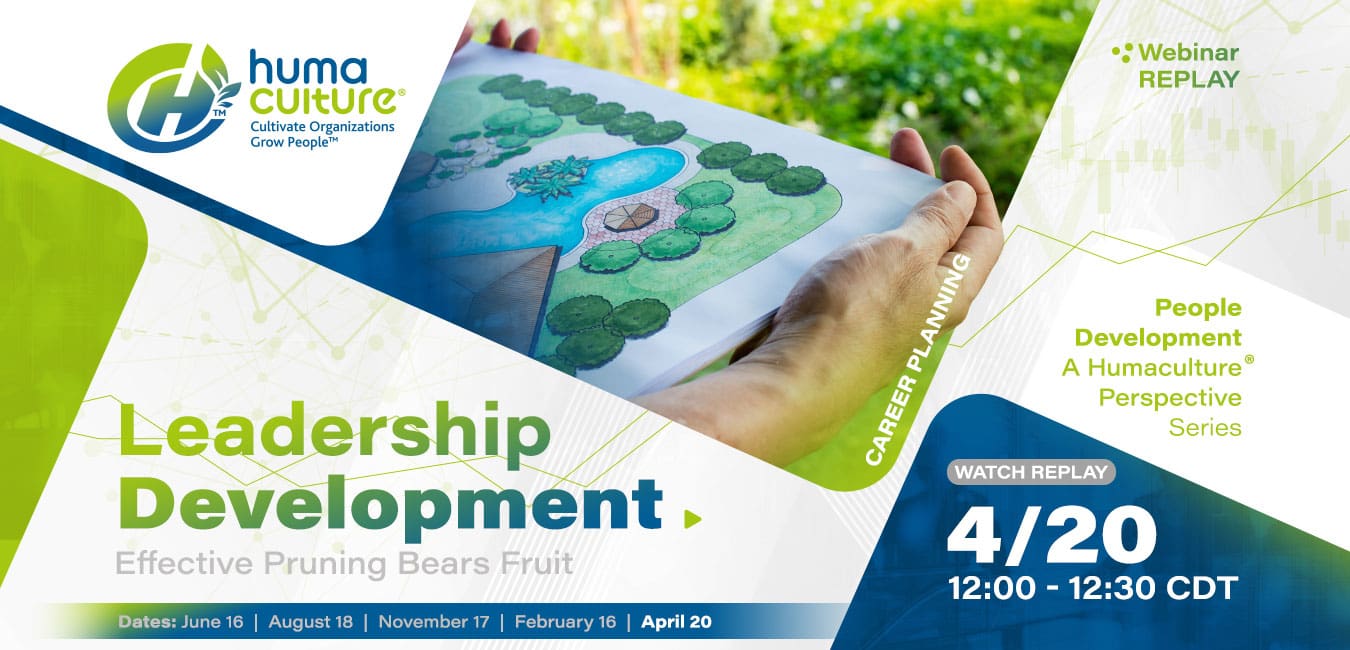
Watch a replay of the fifth webinar in Humaculture, Inc.’s “People Development: A Humaculture® Perspective Series” to learn how to conduct Career Planning to support leadership development, and why “Effective Pruning Bears Fruit” by building leadership capabilities.
Presenters
- Steve Cyboran, ASA, MAAA, FCA, CEBS, actuary and strategy consultant
- Wes Rogers, Humaculturist® and strategy consultant
- Christi Green, RN, MS, PHR, strategy and people consultant
Objective
We’ve talked about how to develop managers to lead to growth and new directions as opposed to staying rooted in the current problems. Now this webinar focuses on how to develop leaders to advance strategy, focus on people, and inspire performance. This results in leadership cultivating the organizational “soil” which leads to real, practical changes that advance the business.
Career Planning: Leadership Development Key Takeaways
During this session, participants will learn that:
- Leaders fail to make decisions
- Leadership vacuums create confusion and a toxic environment
- Leaders who lack a broad perspective undermine operations
- For effective leadership development organizations must:
- Understand effective leadership qualities
- Build and cultivate the right organizational “soil”
- Develop leaders who have good intuition and decision-making skills
- Ensure well-rounded leadership team with appropriate autonomy
- Nurture and develop for intended purposes
Available Support
We are available to support you in your strategy, design, compliance, financial, and monitoring needs. Our team includes business and human relations leaders, finance experts, actuaries, clinicians, behavioral health experts, pharmacy experts, and legal resources to guide you through the strategy and compliance process. Please contact us: [email protected].
Watch
Watch the Career Planning: Effective Pruning Bears Fruit: Manager Development Webinar Replay via Rumble or YouTube.
Career Planning: Effective Pruning Bears Fruit: Leadership Development
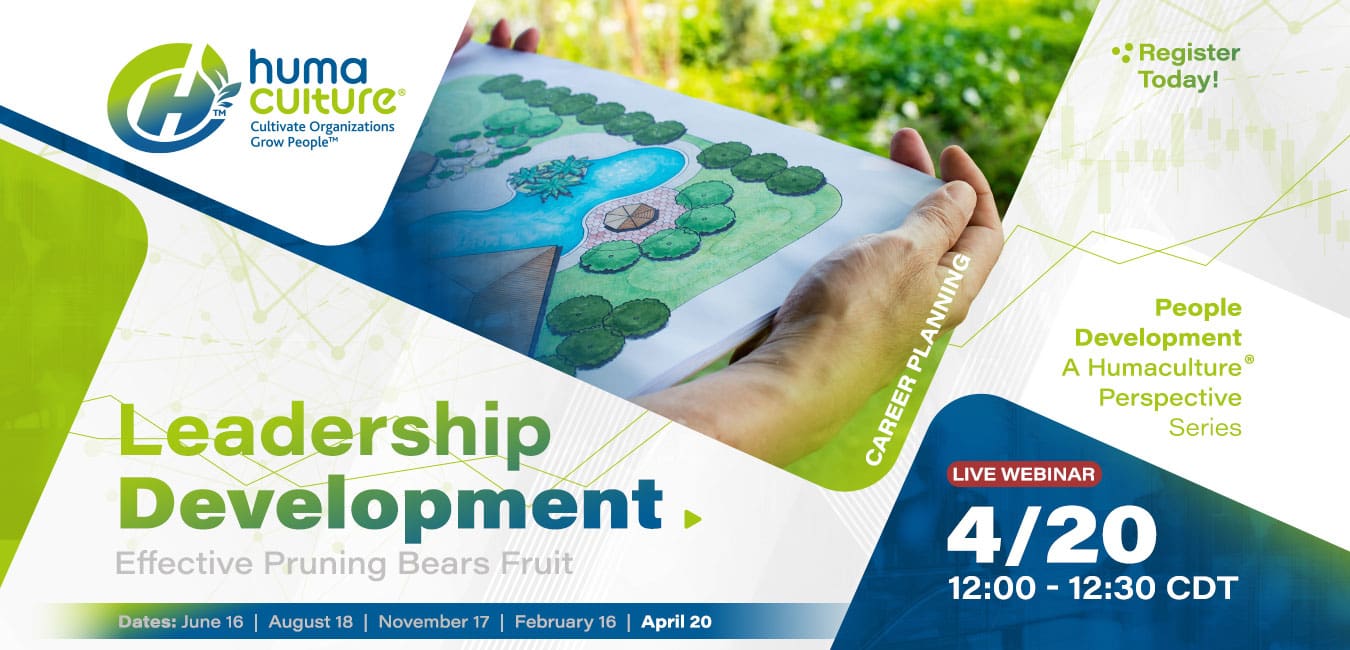
Join us on Thursday, April 20 from 12:00 to 12:30 CDT for the fifth webinar in Humaculture, Inc.’s “People Development: A Humaculture® Perspective Series.” You will learn how to conduct Career Planning to support leadership development, and why “Effective Pruning Bears Fruit” by building leadership capabilities.
Presenters
- Steve Cyboran, ASA, MAAA, FCA, CEBS, actuary and strategy consultant
- Wes Rogers, Humaculturist® and strategy consultant
- Christi Green, RN, MS, PHR, strategy and people consultant
Objective
Last webinar, we talked about how to develop managers to lead to growth and new directions as opposed to staying rooted in the current problems. Now it’s time to talk about how to develop leaders to advance strategy, focus on people, and inspire performance. This results in leadership cultivating the organizational “soil” which leads to real, practical changes that advance the business.
Career Planning: Leadership Development Key Takeaways
During this session, participants will learn that:
- Leaders fail to make decisions
- Leadership vacuums create confusion and a toxic environment
- Leaders who lack a broad perspective undermine operations
- For effective leadership development organizations must:
- Understand effective leadership qualities
- Build and cultivate the right organizational “soil”
- Develop leaders who have good intuition and decision-making skills
- Ensure well-rounded leadership team with appropriate autonomy
- Nurture and develop for intended purposes
Webinar Replay: Effective Pruning Bears Fruit: Manager Development
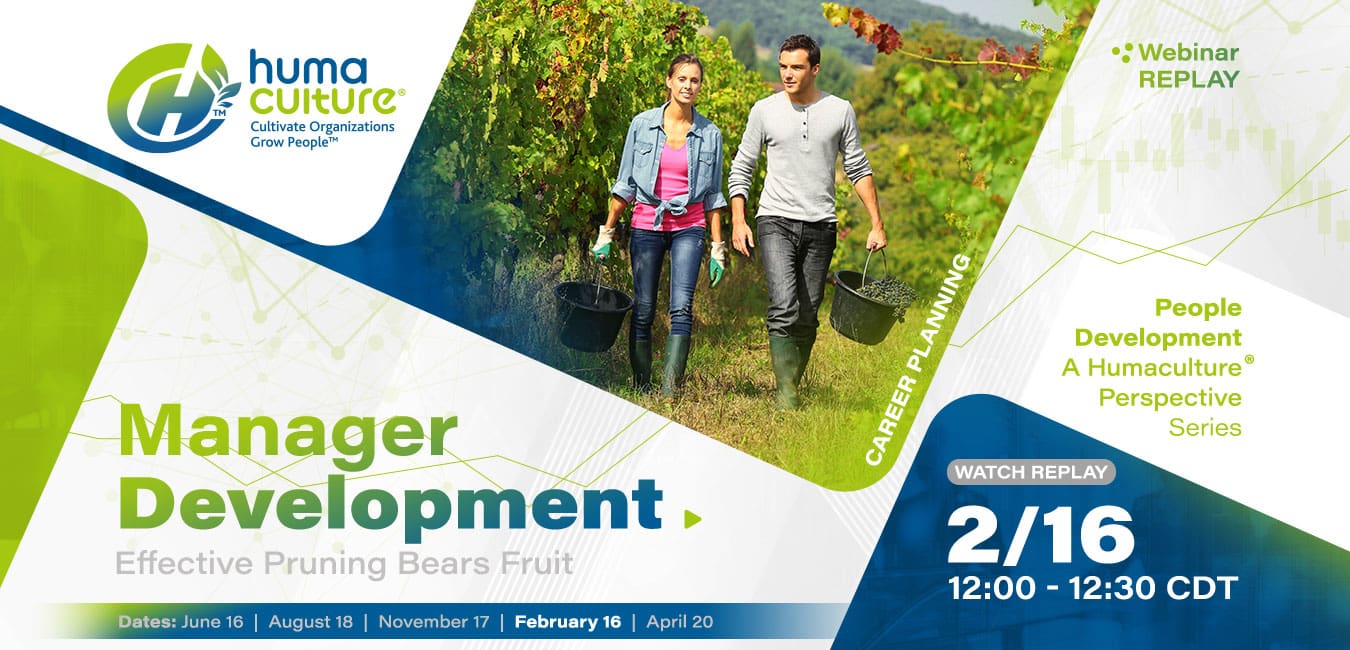
Watch a replay of the fourth webinar in Humaculture, Inc.’s “People Development: A Humaculture® Perspective Series” to learn how to conduct Career Planning to support manager development, and why “Effective Pruning Bears Fruit” by building manager capabilities.
Presenters
- Steve Cyboran, ASA, MAAA, FCA, CEBS, actuary and strategy consultant
- Wes Rogers, Humaculturist® and strategy consultant
- Christi Green, RN, MS, PHR, strategy and people consultant
Objective
We’ve talked about how to “Effectively Prune” to activate and inspire our workplace AND workforce to further grow and develop employees. Now this webinar focuses on how to develop managers to facilitate growth instead of control, to focus on people in addition to results, and to be vision driven instead of a problem solver. This leads to growth and new directions as opposed to staying rooted in the current problems.
Career Planning: Manager Development Key Takeaways
During this session, participants will learn that:
- Organizations fall into the “star” employee syndrome
- Organizations don’t think from a people development perspective
- Culture of Control creates a toxic environment
- For effective manager development organizations must:
- Promote intentionally to fulfill vision, mission, values
- Effectively identify manager qualities/potential
- Develop and deploy learning and growth opportunities
- Shift from Culture of Control to Culture of Growth
- Prepare for appropriate transitions
Available Support
We are available to support you in your strategy, design, compliance, financial, and monitoring needs. Our team includes business and human relations leaders, finance experts, actuaries, clinicians, behavioral health experts, pharmacy experts, and legal resources to guide you through the strategy and compliance process. Please contact us: [email protected].
Watch
Watch the Career Planning: Effective Pruning Bears Fruit: Manager Development Webinar Replay via Rumble or YouTube.
Career Planning: Effective Pruning Bears Fruit: Manager Development

Join us on Thursday, February 16 from 12:00 to 12:30 CDT for the fourth webinar in Humaculture, Inc.’s “People Development: A Humaculture® Perspective Series.” You will learn how to conduct Career Planning to support manager development, and why “Effective Pruning Bears Fruit” by building manager capabilities.
Presenters
- Steve Cyboran, ASA, MAAA, FCA, CEBS, actuary and strategy consultant
- Wes Rogers, Humaculturist® and strategy consultant
- Christi Green, RN, MS, PHR, strategy and people consultant
Objective
We’ve talked about how to “Effectively Prune” to activate and inspire our workplace AND workforce to further grow and develop employees. Now it’s time to talk about how to use management to grow instead of control, focus on people in addition to results, and be vision driven instead of a problem solver. This leads to growth and new directions as opposed to staying rooted in the current problems.
Career Planning: Manager Development Key Takeaways
During this session, participants will learn that:
- Organizations fall into the “star” employee syndrome
- Organizations may not think from a people development perspective
- Culture of Control creates a toxic environment
- For effective manager development organizations must:
- Promote intentionally to fulfill vision, mission, values
- Effectively identify manager qualities/potential
- Develop and deploy learning and growth opportunities
- Shift to a Culture of Growth with accountability
- Prepare for appropriate transitions
Leadership & Tomatoes: 3 Business Principles from My Garden

About 1 in 3 people aspire to a leadership role in business.1 About 1 in 3 people grow a kitchen garden.2 The motivation is the same with both demographics. What is it? The tomatoes, of course. Business success. The harvest.
In turn, successful businesses and successful gardens also have something in common: the people who are rooting (pun intended) for it all to be a thriving ecosystem, resulting in a bountiful harvest for everyone.
Over the years, I have observed that many horticulture principles can provide insights and understanding to help those in leadership build more successful organizations.
Leadership Principle #1 — First build the soil.
Without first building healthy soil, gardening is unlikely to be successful. Well-prepared, deep garden soil gives plants the best opportunity to grow a strong root system.
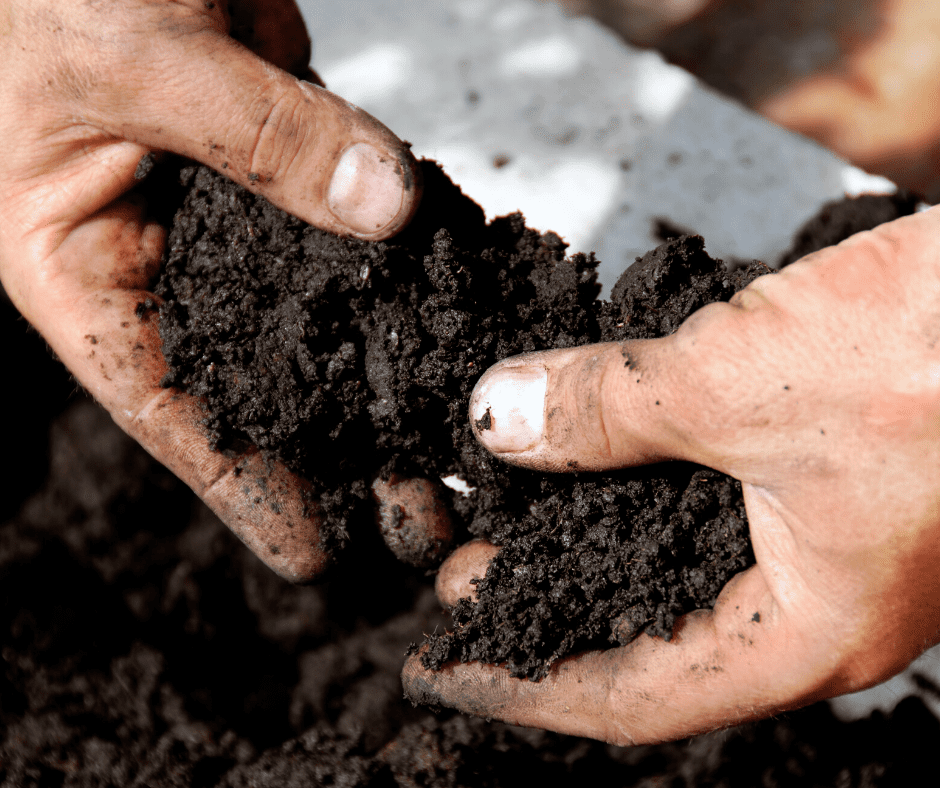
In my garden, I till the soil each spring while the temperatures are still dipping below freezing. I add compost, fall leaves, and grass clippings to add nutrients and texture to the soil. I add alkaline wood ash from winter fires to maintain the soil’s pH balance, since I know my iron-laden well water tends to acidify the soil over time.
Well-prepared soil ensures the plants have the nutrients they need. Good soil also maintains a more consistent temperature, and it allows excess water to drain away faster, retaining only a healthy amount of moisture and retaining it longer.
If we think of businesses and organizations as the soil in which we grow and earn our living, we can easily begin to see parallels between a garden and an organization. An organization that is well prepared has sufficient capitalization, delivers products and services consistent with its vision and mission, is conducive to employee health and well-being, has reserves to weather economic storms, etc.
Most new businesses fail because those who form them are focused primarily on the success they hope to achieve (i.e. harvesting a bumper crop of metaphorical tomatoes), rather than first focusing on the soil preparation that will be critical to that success.
Leadership Principle #2 — Support the plants as they grow.
Once the soil is prepared, the hardest work is done. I have created a nutrient-rich, foundational environment the tomato plants can send deep roots down into and draw resources from to thrive.
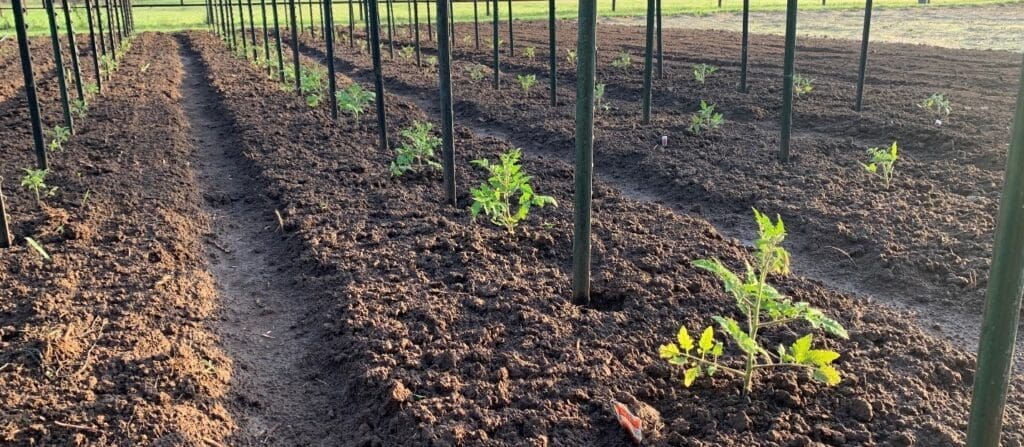
In addition to building the soil, I also have further resources to ensure the tomatoes’ success. I supply supports for the plants as they grow taller and bend under the weight of their fruit. I provide irrigation, giving plants the extra water they need in the dry summertime. I walk through the garden almost every day to identify stressors affecting the plants so I can intervene with extra support if necessary.
Employees—even those in the best-prepared organizational soils—will experience negative stressors and challenges from time to time. Distressed tomato plants, just like people experiencing excessive stress, will never be as productive as they would be if they were healthy, and the quality of what they produce will likely be lower as well. Like a horticulturist walking through the garden, a person in a leadership position needs to be able to recognize when something is preventing the employees within their span of care from fully thriving.
Perhaps the employee is not well-matched to the job; they might benefit from transplanting to another area of the organization. Perhaps some benefits, compensation, recognition and performance management programs, advancement pathways, etc. are not properly designed to align with the organizational vision or mission; more beneficial behavioral designs could be put in place instead. Perhaps there are organizational climate challenges; the team might need special support during especially trying times to overcome the difficulties and thrive.
Often, the problem lies not with the employee, but with the organization and whether it optimizes the availability of its resources so employees can effectively leverage them and thrive.
Leadership Principle #3 — Plants don’t exist for soil; soil exists for plants.
The primary focus of a successful garden is never actually the plants. Plants come and go. If they are happy and healthy in well-built soil, they will thrive and produce a great crop.
Yet I never think of my tomato plants as resources to be exploited. Rather, in partnership and anticipation, I provide them with great soil and support them as they grow and produce. Most of my effort is directed into building the soil for the plants and making sure they have everything they need to thrive; the plants themselves do the rest. Both my tomatoes and I work in this gardening venture, looking ahead to the reward – a bountiful harvest.
One of the most important lessons I have learned from gardening is that just as the plants do not exist for the soil, people do not exist for the organization. Employees—humans—are not “resources” or “capital.” In fact, these terms have come to bother me deeply. “Capital” and “resources” are things an organization owns, rents, or acquires through debt to produce a product or deliver a service. Grouping people into a category of owned or rented assets is very discomforting to the thoughtful person.
Further, I have observed that developing policies and practices based on the analogy of owning or renting people (as the capital/resources terminology implies) leads to confusion on many fronts. Ultimately, it often leads to employees who are demoralized and perform poorly.
So, what if we thought of businesses and organizations as soil created for people to grow and thrive in? What if we thought of the organization’s resources as the support people need to produce abundant value (the harvest)? Organizations do not own employees. Employees are not the resource. Organizations are the soil in which people can root themselves to do meaningful, fruitful work – to grow and to thrive.
Just like I build the soil for my tomato plants because they grow better in a prepared garden, people create organizations of all sorts because we grow better and accomplish more together.
Practical Applications
So, if we change the way we think about organizations and people, how do we also rethink the way leadership handles traditional “human resources” or “human capital” topics (e.g. pay, talent development, performance management, benefits, time off, total rewards, etc.)? In other words, what is the practical application of these principles?
The Humaculture® approach addresses this. In order to apply the concept of building the soil, we first have to ask some questions: Why does the organization exist? What is its vision? In what sort of climate does the organization operate?
After gaining some clarity about these factors, the Humaculture® approach leads us to consider which people will best achieve the organization’s vision and mission (peach trees are unhelpful if the goal is a tomato crop, just as nurses are unlikely to design the best engine for a cutting-edge vehicle prototype).
The Humaculture® approach also leads us to consider what structure and delivery of the organizational resources will allow the people—and, in return, the organization—to thrive and be abundantly fruitful.
It might seem like more work at the outset, but the tomatoes (the fruit, the value created) are always worth it.
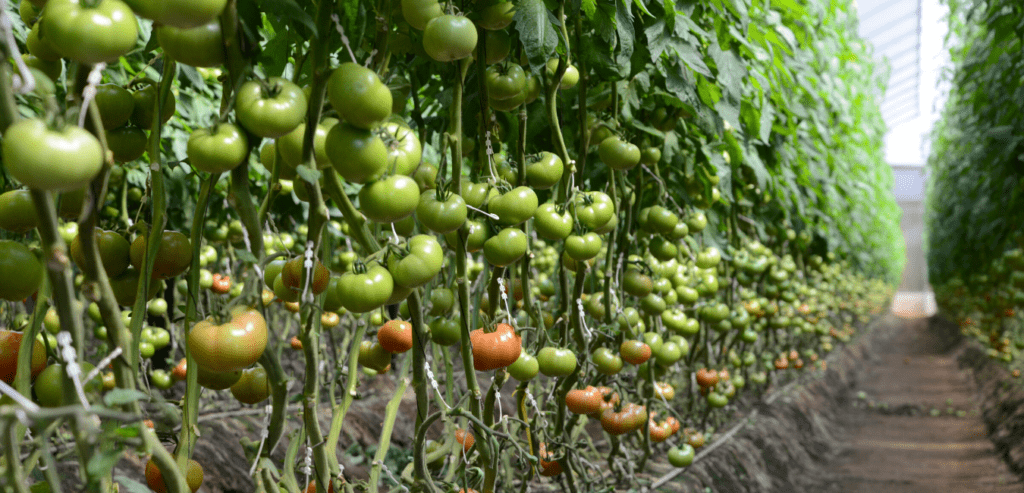
1 http://press.careerbuilder.com/2014-09-09-Majority-of-Workers-Dont-Aspire-to-Leadership-Roles-Finds-New-CareerBuilder-survey
2 http://www.farmerfoodshare.org/farmer-foodshare/2017/6/15/gardening-boom-1-in-3-american-households-grow-food
Author:
Wes Rogers, Chief Guidance Officer for Humaculture, Inc. Wes has almost 35 years’ experience in consulting and senior management positions with a variety of organizations, facilitating groups of people with diverse perspectives and objectives to coalesce around a singular vision and marshal resources to achieve the vision. This experience provides exceptional insights into how organizations operate and succeed. Contact Wes at [email protected].
Contributor:
Steve Cyboran, ASA, MAAA, FCA, CEBS, Chief Behavioral Officer, Consulting Actuary for Humaculture, Inc. Over the past 30 years, Steve has worked extensively with leading corporations, higher education institutions, and health systems across the country to articulate a vision for a healthy and effective workplace culture, develop a total rewards strategy to support that vision and brings deep benefits expertise with a behavioral approach and sound analytics to achieve and measure the desired outcomes. Contact Steve at [email protected].
Edited by:
Rachel Rogers, Editor for Humaculture, Inc. Rachel holds an A.A. in Liberal Studies with an emphasis in English and Communications. As a published writer with training in creative storytelling and corporate storytelling, her experience with writing, editing, and advising writers includes both technical and academic documents, as well as creative works.
About Humaculture, Inc.
Humaculture, Inc. transforms organizations—the way organizational leaders understand the organization and the relationships among the people in it, and the way people think about their position and role in the organization. Humaculture® is a philosophy and systematic approach for creating profitable, aligned, and healthy organizations conceptualized as “soil” in which people can thrive. Humaculture® helps organizations create the right culture in order to naturally attract, retain, sustain, grow, and transition people who enable the business—and each other—to thrive. More information can be found at: Humaculture.com.
